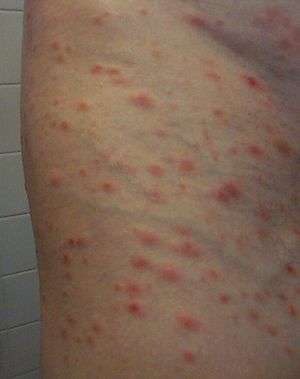Pityriasis lichenoides et varioliformis acuta
Pityriasis lichenoides et varioliformis acuta (PLEVA) is a disease of the immune system. It is the more severe version of pityriasis lichenoides chronica. The disease is characterized by rashes and small lesions on the skin. The disease is more common in males and usually occurs in young adulthood, although it has been seen in every age group and every race. It is possible for the disease to go into remission for short periods of time or forever.
| Pityriasis lichenoides et varioliformis acuta | |
|---|---|
| Other names | Acute guttate parapsoriasis, Acute parapsoriasis, Acute pityriasis lichenoides, Mucha–Habermann disease, Parapsoriasis acuta, Parapsoriasis lichenoides et varioliformis acuta, Parapsoriasis varioliformis[1]:456[2]:736) |
 | |
| Specialty | Dermatology |
Causes
There is no known cause of this disease;[3] There is some evidence associating it with Parvovirus B19.[4]
Diagnosis
It is commonly misdiagnosed as chickenpox or rosacea. PLEVA is also often misidentified as a form of staph. The most accurate way to diagnose it is by biopsy. This disease has not been known to be life-threatening. However, there may be mutations of the disease that can cause ulcers on the exterior.
Treatment
It is not contagious and currently there is no cure for the disease, although the lesions can be treated with phototherapy as well as antibiotics, including erythromycin, azithromycin and tetracycline.[5]
Treatment often involves multiple therapies that address the immune system and bacterial, viral, or dermatological causes.
Eponym
PLEVA is also known as Mucha–Habermann disease. It is named for Rudolf Habermann (1884–1941), a German dermatologist, and Viktor Mucha, an Austrian dermatologist.
See also
- Cutaneous T-cell lymphoma
- Pityriasis lichenoides
- Parapsoriasis
- List of cutaneous conditions
References
- Freedberg, et al. (2003). Fitzpatrick's Dermatology in General Medicine. (6th ed.). McGraw-Hill. ISBN 0-07-138076-0.
- James, William D.; Berger, Timothy G. (2006). Andrews' Diseases of the Skin: clinical Dermatology. Saunders Elsevier. ISBN 0-7216-2921-0.
- "PLEVA, or Mucha-Habermann disease - MayoClinic.com". Archived from the original on 2007-07-15. Retrieved 2007-11-18.
- Tomasini D, Tomasini CF, Cerri A, et al. (2004). "Pityriasis lichenoides: a cytotoxic T-cell-mediated skin disorder. Evidence of human parvovirus B19 DNA in nine cases". J. Cutan. Pathol. 31 (8): 531–8. doi:10.1111/j.0303-6987.2004.00186.x. PMID 15268707.
- Linsey Davis (January 4, 2013). "High School Basketball Star Must Tan to Treat Rare Disease". ABC News. Retrieved January 4, 2013.
Doctors say the ultraviolet technique is so effective that Borrelli cannot miss a single day of tanning, especially since the disease can resurface at any time and cause life-threatening complications in adults.
External links
| Classification | |
|---|---|
| External resources |